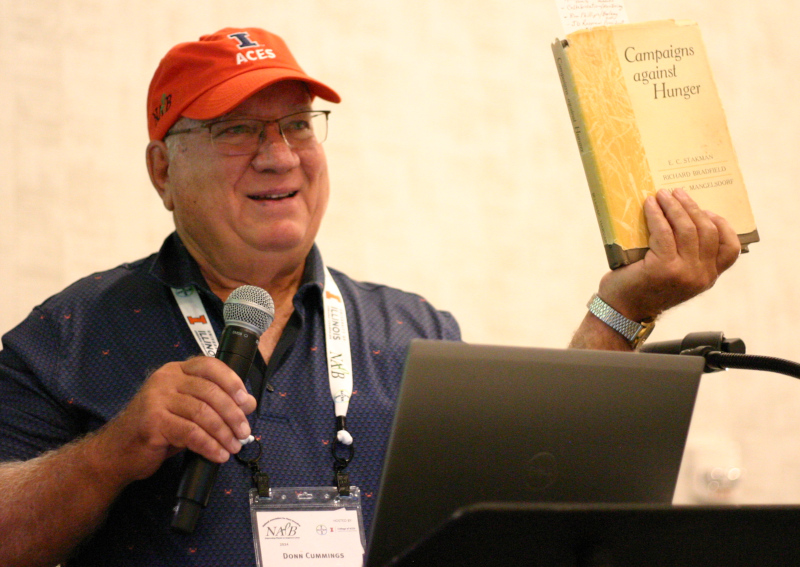In today’s world, plant breeders are under immense pressure to develop innovative varieties that meet consumer preferences and withstand climate change challenges. The National Association for Plant Breeding (NAPB) is rethinking the profession by emphasizing the crucial role of collaboration and mentoring, which are the cornerstones of their success and growth.
Call it going back to basics, if you will.
The thriving Borlaug Scholars program is a testament to this approach, continuing to expand with the support and dedication of sponsors and mentors. This year, the program features 24 scholars and held its annual Borlaug Scholars breakfast in conjunction with the George Washington Carver Scholars program, another NAPB initiative celebrating eight scholars this year.
Donn Cummings, the retired Monsanto employee who founded the Borlaug Scholars program, addressed attendees, emphasizing the program’s value and the profound impact of mentorship. He shared how Ron Phillips from the University of Minnesota, who sadly passed away this year, gave him a book titled The Campaign Against Hunger 50 years ago, marking the beginning of his journey in plant breeding. This book, along with the experience of introducing Nobel Peace Prize winner Norman Borlaug, profoundly influenced Cummings’ life.
“Ron emphasized the ongoing nature of the Campaign Against Hunger, a post-World War II initiative aimed at building world peace through food security. This campaign required continuous, collaborative effort, involving many people dedicated to a shared goal.”
Recently, Cummings attended the 50th reunion of that event in Minnesota, where 20 of the 50 Hayes Phillips scholars gathered. As the third scholar, Cummings was the oldest one there.

“These reunions are more than just nostalgic gatherings; they mark our journeys and remind us to embrace the special moments along the way,” he said.
Another significant mentor-mentee relationship in his life was with incoming NAPB president J.D. Rossouw of Bayer Crop Science, then an early career breeder from South Africa who came to his station.
Rossouw spent nearly six months there, learning about the breeding programs. Over time, Rossouw’s career soared, and he eventually led South African corn breeding before overseeing breeding in China.
“Our shared experiences, including a memorable conference in South Sulawesi where I was the only U.S. attendee among 400 global participants, solidified our bond. J.D. transitioned from mentee to mentor, and I am incredibly proud to see him as NAPB president today.”
Cummings’ story was an inspirational tale for the scholars present, who included Kyle Parker, who’s nearing the completion of his PhD in the Texas A&M Wheat Breeding Program, focusing on quantitative and comparative genomics for wheat improvement. He already has a job with Bayer Crop Science in St. Louis as a product design scientist.
“The Borlaug scholarship is so important to community building. What the program does is connect you with a mentor, and so you’re kind of connected to the broader plant breeding community, rather than if you’re just working in your own lab, where you only have access to the advisors that are immediately around you,” he says.
“And so this can let you interact with people all across the country and get different viewpoints and perspectives that you can take into your own work. It also puts you up on the stage in front of everyone else in the breeding community. And so I think that that’s the biggest aspect, is just kind of connecting your face and your name with what you like to do with everyone else who also likes to do those things.”

Why the NAPB Changed its Name
Rossouw sat down with Seed World to talk about why the NAPB has changed its name from the National Association of Plant Breeders to the National Association for Plant Breeding.
About two years ago, discussions began within the NAPB about making the organization more inclusive, he said.
“The focus was on the influx of new talent from universities, bringing diverse experiences and backgrounds that spanned multiple disciplines. To better reflect this diversity and the evolving scope of the organization, a proposal to change the name was put to a vote.”
The result was a shift from the National Association of Plant Breeders to the National Association for Plant Breeding. The new name better encapsulates what NAPB does by broadening the scope of who should be members, he says.
“It brings together a diverse range of disciplines to support the plant breeding field. Over the years, the technologies and skills represented within the association have evolved significantly. By changing the name, NAPB acknowledges this shift and better represents the multifaceted nature of modern plant breeding.”
The new name is expected to have a positive impact on NAPB’s ability to conduct outreach and attract new members.
“It’s more inclusive, inviting individuals who may sit on the fringes of traditional plant breeding into the association. This inclusivity broadens the perspectives within the organization and enhances collaboration and partnerships across various disciplines. By doing so, NAPB aims to foster a more collaborative environment that leverages diverse skills to advance plant breeding.”
The name change aligns with the strategic direction NAPB has been building towards for the next five years. It reflects a deliberate effort to make the association more inclusive and bring in the right expertise to achieve the strategic goals.
“This change is not just about a new name; it’s about enhancing the association’s ability to deliver on its mission by incorporating a wider range of scientific backgrounds and skills,” Rossouw added.

Rethinking Breeding
This morning’s conference session was all about rethinking plant breeding. Katy Martin Rainey, professor of agronomy at Purdue University, shared her insights on how the field is transforming. She highlighted the evolution of plant breeding and the lessons learned along the way.
Her career has spanned various aspects of plant breeding. She’s tackled heat tolerance, food-grade soybeans, and even seed composition and the integration of unmanned aerial systems (UAS) into breeding programs. Her work with drones, genomics, and phenomics has been pivotal, demonstrating how modern technology can revolutionize plant breeding.
“Historically, breeders have relied on observable traits and yield measurements to select superior lines. However, advancements in genomics and phenomics are changing this approach. By utilizing drone data, breeders can now track traits that were previously difficult to measure, such as canopy coverage and biomass,” she said.
She shared several case studies to illustrate the potential of drone data in plant breeding. In one study, her team used canopy coverage as a measure of growth rate and leaf area to predict yield in soybeans. The results were promising, showing that lines selected using drone data had higher yields than those selected through traditional methods. This approach was further validated through collaborative projects with public soybean breeding programs in Illinois, Ohio, and Michigan.
“The adoption of drone phenotyping in breeding programs represents a significant shift in how traits are assessed. There’s a need for continued research into the physiological processes underlying these traits. For example, the widely used R8 score for soybean maturity was established decades ago based on its reliability as a visual indicator. However, modern technology could provide a more nuanced understanding of maturity and other critical traits.”













